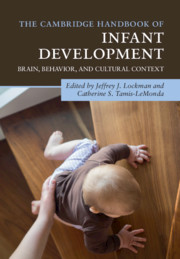Book contents
- The Cambridge Handbook of Infant Development
- The Cambridge Handbook of Infant Development
- Copyright page
- Dedication
- Contents
- Illustrations
- Contributors
- Preface
- Part I Foundations
- Part II Perceptual Development
- 6 Visual Development
- 7 Infant Visual Attention
- 8 Infants’ Perception of Auditory Patterns
- 9 The Development of Touch Perception and Body Representation
- 10 The Development of Infant Feeding
- 11 The Development of Multisensory Attention Skills
- Part III Cognitive Development
- Part IV Action
- Part V Language
- Part VI Emotional and Social Development
- Index
- References
11 - The Development of Multisensory Attention Skills
Individual Differences, Developmental Outcomes, and Applications
from Part II - Perceptual Development
Published online by Cambridge University Press: 26 September 2020
- The Cambridge Handbook of Infant Development
- The Cambridge Handbook of Infant Development
- Copyright page
- Dedication
- Contents
- Illustrations
- Contributors
- Preface
- Part I Foundations
- Part II Perceptual Development
- 6 Visual Development
- 7 Infant Visual Attention
- 8 Infants’ Perception of Auditory Patterns
- 9 The Development of Touch Perception and Body Representation
- 10 The Development of Infant Feeding
- 11 The Development of Multisensory Attention Skills
- Part III Cognitive Development
- Part IV Action
- Part V Language
- Part VI Emotional and Social Development
- Index
- References
Summary
The world presents an array of constantly changing sights and sounds, tactile and vestibular experiences, far too much to be attended and processed at any one time. Perceivers must make sense of this dynamically changing flux of stimulation by selecting events and properties of events that provide information that is meaningful and relevant to their needs, goals, and actions as they change across time. Adults are highly skilled at selectively attending to this multisensory stimulation in a way that optimizes perception and learning and supports their actions and goals. However, this selective attention presents a remarkable challenge for young infants – how to learn to attend to the dimensions of stimulation that optimize meaningful perception and action and to filter out stimulation that is less relevant.
Keywords
- Type
- Chapter
- Information
- The Cambridge Handbook of Infant DevelopmentBrain, Behavior, and Cultural Context, pp. 303 - 338Publisher: Cambridge University PressPrint publication year: 2020
References
- 5
- Cited by



